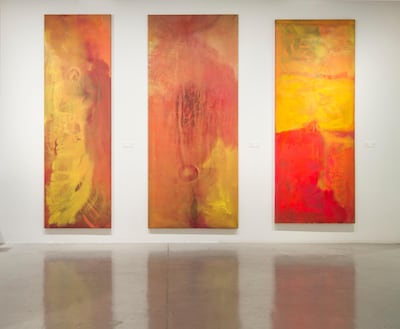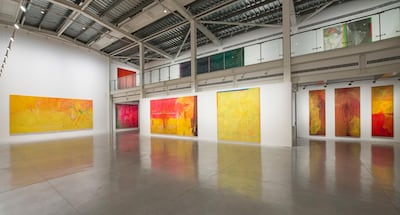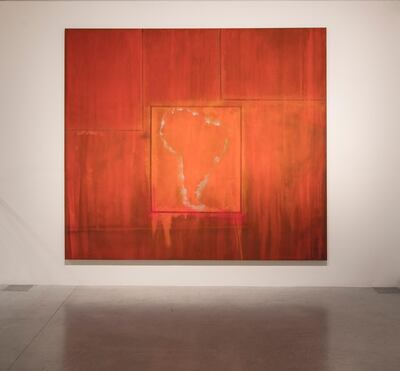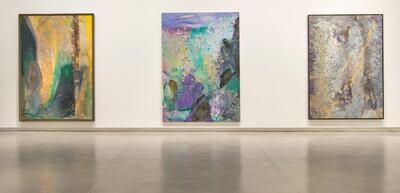"There's a clash between being a painter and being a 'black painter'," says Benjamin Bowling about his father, artist Frank Bowling. We're at the opening of Mappa Mundi, an exhibition of Frank's paintings of luminosity and texture at the Sharjah Art Foundation. His work provides an object lesson in how we understand minority art histories. How important is an artist's identity?
The artworks on show in the UAE span Frank’s 1960s and 1970s sojourn in New York. Some haven’t been seen for decades, and have remained rolled up in storage since the ’70s. Frank himself couldn’t be at the event because of a scheduling conflict; the 84-year-old can still be found in the studio everyday.
Born in British Guyana in 1934, Frank emigrated to London when he was 19. He studied at the Royal College of Art and then for a master’s at Slade School of Fine Art. At 32, he travelled to New York, looking for “that American thing”.

That’s how Dia Art Foundation’s deputy director and chief curator, Courtney Martin, put it at a conference held to accompany the show’s opening. But Bowling encountered, instead, an entirely new context of racial histories and perceptions. “In the US he had to think about his identity in a different way,” Benjamin tells me. “He hadn’t thought of himself as a black artist before.”

His work changed. He began incorporating images of Africa and Guyana into his paintings. In one, titled Middle Passage, he suggests his own itinerary, from Guyana to Britain to the United States, as an echo of the slave trade from Africa via the UK to the American South. In others, he refers back to his home in Guyana, with its colonialist architecture, and peppers canvasses with the Union Jack. His blackness, and its history, came to the fore.
But this story can also be told differently. When he moved to New York in 1966, it was the height of Pop art. His work changed; he became a Pop artist. The well-known artist Larry Rivers introduced him to silkscreening, and the paintings he subsequently made overlap intriguingly with Warhol's. Benjamin points out the photographs that had been silkscreened onto Where Is Lucienne?, painted in 1971 in New York. Nearly hidden by the saturated colour are Frank's mother and his two other sons (Benjamin's brothers) repeated in sections across the painting. There is a clear link to Warhol's Death and Disasters series, where Warhol reprinted images of car crashes or dead personalities such as Marilyn Monroe to suggest a numbness through media repetition and spectacularisation. Frank's repeated faces of his family, particularly that of his mother, whom he left in Guyana, bear the same feel of tragedy – and for his young sons, a tragedy to come.
So which is it? Black artist or artist? The conference at the Africa Hall, “5 plus 1”, sought to unravel this persistent dilemma by the best means possible: research. Organised by Sheikha Hoor Al Qasimi, director of the Sharjah Art Foundation; Salah Hassan, an advisor to the Africa Institute; and Okwui Enwezor, who co-curated the show in its first incarnation at the Haus der Kunst in Munich, the conference brought together key curators and academics studying the Black Arts Movement and black art history. Curator Zoe Whitley discussed her findings for the well-received show Soul of a Nation: Art in the Age of Black Power, at Tate Modern last year. Northwestern University professor Krista Thompson gave a presentation on Tom Lloyd, a multimedia artist whose career, she argued, suffered because he refused to make “black work”. His name was included on a list for a Whitney Biennial in the 1960s, and then (literally) crossed out.
Many stressed the diversity of the African diaspora experience that is overridden by racial terms. This was implicit in the conference’s title, “5 plus 1”, taken from the name of an exhibition that Frank curated in 1969 at the Stony Brook University art gallery in Long Island. There were five black artists, plus one – Frank, a more established artist, whose history of migration differed from that of the American artists he encountered, and one who travelled to the US with elite degrees from the British art education system.
Identity questions aside, the paintings tell their own story. The works Frank made in New York are extraordinary; they seem to levitate by the sheer beauty of their bright colours, and they are awe-inspiringly ambitious. Anna Schneider, Enwezor’s co-curator at the Haus der Kunst, said Frank had Velazquez and Goya in mind when he painted them. But they are not grand for grandness’s sake: Frank sought to marry abstraction with social questions and current events, grounding American formalism in a European connection to events on the ground. By using his own itinerary from Guyana to the UK and US, and images of his own past and family, Frank put his experience front and centre – not the experience of a minority party, but experience befitting the full artistic treatment of history-painting canvases, triptychs, and post-war abstraction. His later works, also shown in Sharjah, feel more sunken, but they retain the aspiration to link abstraction with the world around him – quite literally.
Made in a studio overlooking the Thames, they reflect on the boggy marshes of the river, the water’s changing colours, and the way it refracts light. Monet here is the reference. They are epic, too: executed on the floor, they amount to, Enwezor has remarked, a whole new language of world-making.
Frank Bowling: Mappa Mundi is on at Sharjah Art Foundation until January 12, 2019
______________________
Read more:
British Library’s Endangered Archives Programme sheds new light on the history of Africa and Islam
Exploring how the Arab world ‘is the origin of so much we take for granted in the West’
British Museum's new gallery shows the influence of Islam in the Middle East and beyond
______________________




